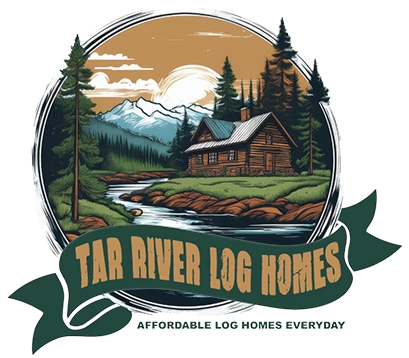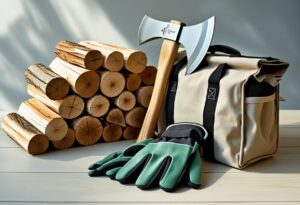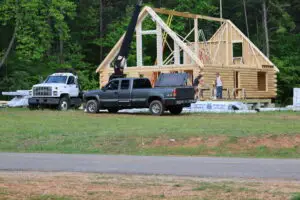When you’re considering a log home, it’s important to know exactly what comes in a kit. This helps you avoid surprises and budget wisely. Many families choose kits because they provide the essentials in one package. You can start with a solid structure and finish at your own pace.
Some kits cover nearly everything you’ll need, while others only include the exterior shell. Understanding these differences keeps you on track. At Tar River Log Homes, we value honesty and simplicity, so we believe it’s best to lay out what you can expect.
In this guide, we’ll break down what’s included in a log kit, plus the extras that can make building smoother
Essential Components of a Log Kit
When you receive a log kit, it comes with several important items that help you track the construction process, record details, and keep your materials organized. These components are designed to simplify your build and ensure you have everything ready at your fingertips.
Logbook
The logbook is your primary reference tool throughout the construction of your log home. It contains detailed information about each piece included in the kit, such as the numbering and placement of logs and beams.
Using the logbook helps you follow the assembly plan step-by-step, reducing errors. It often includes diagrams, notes on structural details, and instructions specific to your design.
Keeping this logbook handy on-site ensures you stay organized and can quickly resolve any questions during your build.
Writing Tools
Writing tools are usually provided or recommended to accompany your kit for marking logs, making notes, or tracking progress. You’ll need tools like pencils or markers that show clearly on wood surfaces but won’t damage the material.
Accurate marking helps in fitting logs precisely according to the numbered instructions. Having quality writing tools ready means you can easily label pieces, mark cuts or adjustments, and record measurements as you work.
This minimizes mistakes and keeps your project running smoothly.
Protective Case
A protective case is included to keep important documents, like your logbook and permits, safe and secure on the job site. It guards against weather conditions, dirt, and damage from handling during construction.
This case is often waterproof and sturdy, designed to protect sensitive papers and smaller tools you want to keep nearby. Using a protective case helps you maintain order and safeguard your essential building information for quick access whenever needed.
Foundation and Site Preparation
Most log kits do not include foundation materials, so you’ll need to prepare the site in advance. According to the National Association of Home Builders (NAHB), foundations typically fit into three categories: slab, crawl space, or basement. Each option has cost, insulation, and moisture-control implications.
Proper site preparation is just as important. Grading and drainage ensure that water flows away from your cabin, reducing the risk of long-term structural damage. Compacting the soil before pouring concrete helps prevent shifting or settling that could affect your log home.
Safety and Maintenance Items
When building with a log kit, having the right safety gear and cleaning supplies is crucial. These items help protect you during construction and keep your log home in great condition over time.
Personal Protective Equipment
You should always have basic personal protective equipment (PPE) on hand. This includes hard hats to protect your head from falling debris and safety goggles to shield your eyes from sawdust and wood chips.
Work gloves are essential to prevent splinters and improve your grip on tools. Hearing protection, like earplugs or earmuffs, is important if you use power tools or heavy machinery.
High-visibility vests can keep you safe on busy sites, especially if others are working around you. Proper footwear, such as steel-toed boots, helps protect your feet from injuries. Including these items in your kit keeps you safe during every step of building.
Cleaning Supplies
Keeping your workspace clean reduces hazards and makes your build smoother. Your log kit should include or prompt you to get basic cleaning tools like sturdy brooms, dustpans, and shop vacuums for removing sawdust and debris regularly.
You’ll also want mild soaps and soft brushes to clean logs during finishing stages without damaging the wood’s surface. Rags or sponges help wipe down surfaces and apply stains or sealants evenly.
Proper cleaning extends the life of your logs and prevents mold or insect problems. Regular maintenance with the right tools keeps your home looking its best from the start.
Additional Accessories Included
You’ll find extra items in a log kit designed to make assembly easier and keep everything organized. These accessories save time and reduce confusion during construction by giving you clear identification and storage options.
Labeling Materials
Labeling materials are key to avoiding mix-ups when building your log structure. Most kits include pre-printed labels, tags, or stickers that correspond to blueprints or assembly instructions.
Each log or piece is clearly marked with a number or code, so you know exactly where it fits in the overall design. Sometimes, kits also provide color-coding systems to help differentiate between walls, beams, and other components.
This speeds up your work and reduces errors, especially if you’re assembling the cabin on your own or with minimal help.
Storage Pouches
Storage pouches come in handy to keep small hardware like nails, screws, brackets, and fasteners organized. These pouches are often made from durable fabric or plastic and are designed to be portable, so you can easily carry and access the items during construction.
Having dedicated pouches helps you avoid misplacing crucial items and streamlines your workflow. Instead of searching for individual pieces, everything you need is grouped and labeled, making your building process smoother and more efficient.
Digital Tools and Resources
You’ll find digital tools that simplify managing your log kit and keep your project organized. These tools focus on easy access and pre-made formats to save you time.
Mobile Application Access
Many log kit providers offer mobile apps to help you manage your project on the go. With these apps, you can track your inventory, view blueprints, and receive real-time updates directly from your phone or tablet.
Apps often include interactive checklists, reminders for important steps, and the ability to store photos or notes. This way, you keep everything centralized without carrying paper documents.
Using mobile access also means you can share progress or ask questions quickly. Communication between you and your builder or supplier becomes smoother and faster.
Online Record Templates
Online templates are a valuable resource for documenting your log kit project. These templates usually come as spreadsheets or fillable forms that help you track supplies, costs, and timelines.
You’ll have access to pre-designed sheets like:
- Material inventory lists
- Budget trackers
- Construction schedules
These templates reduce the chances of missing vital details and ensure your project stays on track. You can easily update and share these documents with your team or contractor for clear communication.
User Guides and Documentation
You’ll find clear instructions and important contact details to help you build and maintain your log kit smoothly. These resources ensure you know each step and have support ready if needed.
Instruction Manual
Your log kit comes with a detailed instruction manual designed to guide you through every phase of assembly. It includes step-by-step directions, diagrams, and a list of parts to help you identify components quickly.
The manual covers essential topics like safety precautions, handling hardware, and recommended tools. It also highlights tips for managing moisture and energy efficiency during installation to protect your new structure.
Having this guide at hand will help you avoid mistakes and streamline the build process. It’s meant to be easy to follow whether you’re a first-time builder or experienced with kits.
Support Contact Information
If you run into questions or need technical help, your log kit package includes support contact details. This typically includes a phone number, email address, and sometimes live chat options.
Support teams usually have set hours but respond promptly to issues like missing parts, assembly difficulties, or warranty queries. Keep this information accessible throughout your project.
Reach out if you feel uncertain about any step or need troubleshooting advice. Direct access to support can save you time and reduce stress during your build.
Optional Upgrades and Add-Ons
When building your log home, you have choices beyond the basic kit. These can enhance the look and longevity of your cabin.
Some upgrades add personal touches, while others prepare you for easy maintenance.
Custom Branding Options
You can personalize your log home with custom branding, such as unique log carvings or logos. These add-ons make your cabin stand out and reflect your style.
Common branding options include:
- Engraved corner joints
- Custom logos on beams or posts
- Decorative notching patterns
These features are crafted before shipping and fit seamlessly with the log system. They don’t affect structural integrity but give your home a personalized feel that lasts.
Replacement Parts
Replacement parts are vital for maintaining your log home over time. Some kit providers offer kits with extra logs, fasteners, or roofing materials for future repairs.
You might receive:
- Spare logs matched to your build
- Additional fasteners and hardware
- Extra tongue-and-groove panels
Having these on hand can save you time and money later. It also ensures repairs blend perfectly with your original materials, keeping your home secure and looking consistent.
Bringing Your Log Kit Plans Together
Understanding what’s included in a log kit makes planning your budget, timeline, and build process much easier. From foundations to finishing touches, knowing what’s in the package helps you avoid surprises.
At Tar River Log Homes, we believe families deserve clear, affordable options without hidden extras. That’s why we focus on transparency and value in every kit we provide.
Ready to start building? Explore our log home kits today and see how simple, affordable, and family-friendly building your dream cabin can be.
Frequently Asked Questions
You’ll find that log home kits include a variety of components tailored to different needs. Some items are standard, while others may require additional purchases. Financing and assembly options also affect your experience.
What items can I expect to find in a typical log home kit?
Most kits include pre-cut and pre-notched logs for walls, beams, posts, and headers. These are labeled for easier assembly. You’ll often get window and door frames according to your chosen plan.
Are there any components that are not typically included in a log cabin kit?
Roofs are usually partially included, with rafters and ridge beams provided. Roofing materials like metal or shingles often need to be bought separately. Items like insulation, plumbing, and electrical systems are commonly excluded.
What are the financial options available when purchasing a log cabin kit?
Payment plans vary. Some offer financing options like loans or layaway plans to help manage costs. You’ll usually need to budget for the kit price plus additional construction expenses.
Can I build a log cabin myself using a DIY home kit?
Yes, many kits are designed for self-assembly with pre-cut components and detailed instructions. Building experience and tools will help the process go smoothly.
How do the costs vary for smaller log cabin kits compared to larger ones?
Smaller kits tend to cost less overall but may have a higher price per square foot due to fixed setup costs. Larger kits benefit from economies of scale but require a bigger initial investment.
Tar River Log Homes is proud to provide only the best products for your log home. We focus on affordability, transparency, and supporting hardworking families throughout the building process.
What makes one log cabin kit more affordable than another?
Differences in included materials, package types, and quality of wood affect prices. Basic shell kits cost less but require more work and additional purchases. Comprehensive packages come at a higher price but reduce extra expenses.
At Tar River Log Homes, we believe in offering only the best products for your log home. We keep things simple and transparent, so you know exactly what you’re getting.





